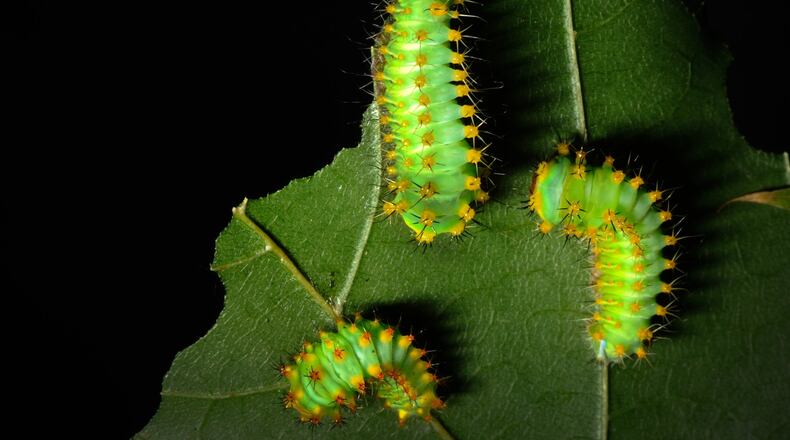Sadly my new favorite perfumes have names like “Off,” “Repel,” and “Deep Woods.”
RELATED: Cottrel: Historic flood planning key for Dayton, Springfield region
This summer it was getting harder and harder for me to accept the important roles insects play in our ecosystem until a friend introduced me to the highly magnified world of moths. And all I can say is — wow.
To me Sarah Bennett Rogers will always be that talented portrait and event photographer who took such lovely photos of one of our family weddings. Once a photographer for the Springfield News-Sun, Sarah has recently expanded her photographic expertise. She loves capturing fantastic photos of nocturnal moths that people rarely see.
“The insect world is like a whole new planet,” Sarah said.
Her masterpieces have reminded me of the beauty and magic of metamorphosis.
READ MORE: Cottrel: Clark County has plenty of local recreation options
As a former science teacher, I technically understand the steps of the metamorphic cycle of moths and butterflies. Eggs become larva that grows into caterpillars. Caterpillars chow down on leaves and gain in size and complexity. Butterflies form a chrysalis but moths spin a cocoon, then they emerge as spectacular winged creatures that don’t even remotely resemble the caterpillar.
Sarah’s photos have reminded me of how strangely bizarre but wonderfully made these eggs, larva, caterpillars and chrysalis are close up. To her even something as simple as a moth’s antenna becomes a work of art.
So last week when Earl Robinson of Meadow View Growers told me about the fantastic stuff they have going on in the Butterfly House at Meadow View Growers, 755 North Dayton-Lakeview Road, I had to visit.
The Butterfly House is that black net tent to the left of the main building at Meadow View. It kind of reminds me of a screened picnic shelter, but the object is to keep the butterflies in.
Rule No. 1 of visiting the Butterfly House is to walk in or exit quickly. You do not want to facilitate the escape of any of these beautiful creatures. They have no idea how great they have it in their predator-free Butterfly House where they live with all the nectar, leaves, water and shelter they want.
DETAILS: Local outdoor adventures offer summer amazement
The first thing that hit me as I entered the building was the heavy scent of herbs. It turns out that the butterflies love to lay their eggs on herbs. In the warm humidity, the parsley, dill, fennel and borage gave off a pleasant scent that mixed with the scent of a variety of flowers. It’s truly a unique treat for the nose in addition to the eyes.
The flowers were all blooming beautifully and a variety of butterflies peacefully flitted from flower to flower, collecting the nectar.
Among the gorgeous blooms, I was a bit surprised to see a couple of herb plants that looked a bit bedraggled. The plants at Meadow View always look so perfect so I wondered why this was. Meadow View associate Deb Campbell explained to me what was going on.
These were the host plants, explained Campbell. The butterflies lay their eggs on the host plant then the larva or caterpillars that hatch feed on the leaves.
She pointed out bright green painted lady caterpillars feasting on the stalks of dill. It was amazing thinking about how those caterpillars would someday form pupa, or chrysalis, and then change into spectacular butterflies.
I wondered how they would look through Sarah’s magnifying lens.
Campbell explained that in a butterfly garden, it’s best to place the host plants behind the flowering plants because the caterpillars have voracious appetites. It is all part of the natural metamorphosis cycle and the host plant plays its important, but not pretty, part.
The host plants are specific for certain butterflies, said Campbell.
“Monarchs will only lay their eggs on milkweed plants,” she said.
I watched monarch butterflies gathering nectar from blooming plants located all over the house. Campbell pointed out the green colored chrysalis of the monarch butterfly attached at various places. More would hatch soon then lay around round of eggs.
Next week it’s hoped that the 10 giant swallowtail butterflies will emerge from their chrysalis. These butterflies have wing spans approximately 5 inches from tip to tip and are Ohio’s largest native butterfly.
The butterfly house isn’t big. But it’s a lovely place for small groups of adults or accompanied children who are old enough to understand the “no touching,” “no swatting” and “no running” rules of the house. Visitors have to be careful not to step on a butterfly resting on the path or a caterpillar that has decided that the plants on the other side of the path look tastier.
On the wall of the butterfly house here are some informative posters explaining metamorphosis and what’s going on here. Host plants and nectar producing flowers were all labeled, which helped me immensely.
Meadow View also had printed suggestions for establishing butterfly gardens, including lists of plants that butterflies love, and host plants that certain types of butterflies require.
Sometime this fall the butterflies will be released so that they can migrate or winter over in their own unique ways. Campbell told me the release will be announced on the Meadow View Facebook page In my opinion the best part of creating our own butterfly friendly gardens is that hummingbirds and honey bees will also enjoy these same flowers.
Now if we can just figure out how to keep the mosquitoes away.
About the Author
